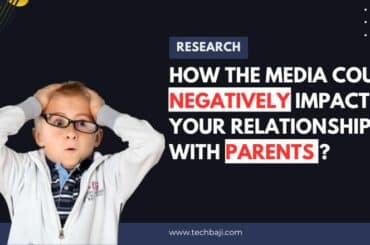Modern technology devices such as smartphones are prevalent among youth. While digital technology use can have an impact on adolescent well-being, it is important to understand how and why technology is used.
Table of Contents
Overreliance on technology can damage self-esteem, create a lack of empathy, and hinder emotional development. Parents should focus on the quality of what their children are doing on their devices.
In this article, we will discuss “Modern Technology Devices and their Impact on Youth” in detail.
Positive impacts of modern technology devices on youth development
Technology devices have positive impacts on youth development. These include:
- Promoting hand-eye coordination in young children
- Developing language and problem-solving skills
- Gaining new learning opportunities, especially for children who are physically or developmentally challenged
- Improving creativity and freedom of expression
- Enhancing socialization and relationship building
- Encouraging independence, goal-setting, and achievement
- Providing immersive experiences that enhance learning in various arts and sciences
However, technology use has also been found to contribute to poor self-esteem and isolation in some children.
Technology often presents children with problems, which helps them learn how to make decisions and improve problem-solving skills.
While there are many positive impacts that can be connected to technology use, there are many negative impacts as well. Let’s discuss those as well.
Negative impacts of modern technology devices on youth development
There are a number of negative impacts that technology devices can have on youth development. These include:
- Diminished attention span: Children who use technology excessively may have trouble focusing on tasks for extended periods of time.
- Health problems: Excessive use of technology can lead to health problems such as obesity, poor sleep quality, and eye strain. You can also read about the effects of technology on health and how we can minimize their impact.
- Social skills issues: Overuse of electronic devices may impair the development of social skills, including the ability to make friends in person, display good manners, and empathize with others.
- Browsing online can be dangerous: Children may be exposed to inappropriate content or predators when browsing online unsupervised.
- Addiction: Children may become addicted to using technology devices, which can disrupt their relationships with family and friends
You must read: Positive and Negative Effects of Technology on Child Development
The impact of technology devices on academic performance
The impact of technology devices on academic performance is a topic of interest for many researchers.
Research indicates that heavy technology use is associated with lower academic performance among adolescents.
However, one study found that among students who had below-average reading skills, higher Internet use was associated with improving those skills.
Appropriate classroom technology boosts students’ academic achievement, self-confidence, motivation in class, and attendance. Technology facilitates students’ transition from sitting attentively and listening to more hands-on learning.
Numerous studies have found that implementing instructional technology improves overall student motivation and engagement in learning.
More specifically, technology engages students behaviorally, emotionally, and cognitively.
The model that included “Time spent using technological devices during weekdays” showed that time spent using a cell phone and playing video games was negatively associated with self-reported academic performance.
Several online risk experiences were also associated with lower academic performance, with lower life satisfaction.
On the other hand, the model that included “Time spent using technological devices during weekends” showed that time spent using a cellphone was negatively associated with self-reported academic performance.
Similar to the results from the weekdays model, several online risk experiences were comprehensive approaches such as the one we conducted in this study.
Our results highlighted the effect of using a cellphone or playing video games on academic performance.
This study examined whether Technology does in fact increase student academic achievement and increase motivation for students to learn.
You must read: Positive and Negative Impacts of Technology on Education
The results show that Technology could be a factor in student academics. Technology can also motivate students and allow them to be engaged on a completely different level than they have ever before.
Further research is warranted to examine whether technology usage might produce comparatively more significant increases in academic achievement than would non-usage.
The impact of technology addiction on youth behavior
Technology addiction can have negative impacts on youth behavior. Spending too much time with technology can interfere with school, relationships, family time, and sleep habits.
It has been linked to stress, loneliness, depression, poor physical health, obesity, family conflict, and delayed launch in young adults.
You can also read about the effects of technology on health and how we can minimize their impact.
Technology negatively impacts kids if they spend so much time on screens that they skimp on eating, sleeping, doing their homework, or spending time with friends.
Some teens and young adults cross from normal use into a realm in which their technology use is having a negative impact on school, work, family, and social life.
You can also read: How Technology is Shaping the Future of Education
Technology addiction includes an addiction to video games, social networking, and surfing the web among other things.
Tech dependence can lead to teen consequences that span from mild annoyance when away from technology to feelings of isolation, extreme anxiety, and depression.
Addiction to technology is real. Numerous studies over the past decade have shown that tech dependence has the same effect on the brain as drug addiction.
Furthermore, adults with a history of drug abuse are more likely to experience addiction to technology. And research shows that teens with Internet addiction are also prone to substance abuse and eating disorders.
In other words, the tendency toward addiction can encompass various forms of addictive behaviors and substances including addiction to technology.
However, some experts point out that an unhealthy obsession with video games may be a sign of an underlying mental health issue or ADHD rather than an addiction.
Others point out the positive benefits of technology use such as teens who struggle to make friends in real life often use social media and digital platforms to make friends.
Treatment for technology addiction involves educating teens and young adults about healthy tech usage habits.
Strategies for managing technology use among youth
Strategies for managing technology use among youth include setting family rules, establishing routines, having sessions, and encouraging choices.
Family rules should be based on fundamental family values and should be discussed, negotiated, and signed as part of a formal agreement.
Rules can help set limits and expectations for technology use. Establishing routines can help minimize conflict about screen time.
For example, having a tech-free family night on Fridays can avoid arguments about using devices. Sessions can also be used to limit technology use; for example, by setting a timer or limiting the amount of time spent on devices.
Finally, encouraging choices about digital technology use can help teens learn to make responsible decisions when it comes to their device usage.
Parents should also strive to be good digital citizens by modeling the behavior they want their children to emulate.
This includes avoiding texting in the car and using devices in a serviceable way. Additionally, creating a family media plan that promotes open discussion and consistent rules about media use is important for establishing healthy boundaries with technology in the home.
Finally, parents should support their teens’ social lives both online and off by discussing healthy relationship skills such as empathy and perspective-taking.
The role of parents in regulating technology use among youth
Parents in the United States are still the primary gatekeepers and managers of their teens’ internet experience.
Parents are the most often cited source of advice and the biggest influence on teens’ understanding of appropriate and inappropriate digital behavior.
You can also read: Difference Between Parenting and Parenthood
In a study, parents were asked if they engaged in actions such as talking with their child about ways to use the internet and cell phones safely or using parental controls to restrict their child’s use of their cell phone.
The study found that parents are more likely to talk with teens about digital safety and behavior issues, and are somewhat less likely to take a more hands-on approach to restrict or monitor their child.
Parental perceptions of technology can affect technology-related parenting strategies for youth. Fathers are often technically competent technology users and delegate more freedom to their children, while mothers are more conservative technology users who tend to be more restrictive with technology use.
Parenting practices used through interactive technology that both parents and early adolescents identified included open communication and monitoring.
You can also read: How the Media could Negatively Impact your Relationship with Parents or Guardians
Parents influence their adolescent’s Internet use by modeling, monitoring, and mediating.
A large body of literature is available regarding parental mediation of adolescents set by parents/caregivers. For example, as adolescents get older, parents’ perceptions tend to change, and teens are given more independence in managing their own online activities.
Future implications of technology use among youth
Technology use among youth has the potential to enable them to ignore political limitations, including country borders, and especially ignore time and distance.
It can also have positive effects such as allowing them to access information quickly and easily, as well as providing opportunities for social connection.
However, it can also have negative impacts on their developing social skills, relationships, health, and overall ability to focus.
Research shows that the amount of time spent using technology can affect cognitive development in adolescents.
Frequently Asked Questions About How Much BMX Riders Make
How does technology affect the social skills of youth?
Technology can negatively affect children’s social skills, leading to more social awkwardness, shyness, and difficulty in social situations.
It can also impact eye contact, phone skills, conversation, spatial awareness, and attention span. Recent research has shown that screen time is negatively associated with social skills development in toddlers.
The development of communication and socialization skills in children and teens is another critically important consideration.
Technology can also lead to a lack of confidence to communicate, isolation, depression, and anxiety.
How does screen time affect youth brain development?
Research suggests that excessive screen time may affect the development of the cortex in youth. It may also inhibit a child’s ability to observe and experience everyday activities they need to learn from.
Studies have linked screen usage to differences in brain structure, particularly in areas responsible for visual processing.
Additionally, it has been suggested that the stimulation provided by screens is “impoverished” compared to reality, and children need a diverse range of experiences for healthy brain development.
What are the negative effects of technology on youth mental health?
Technology can have negative effects on youth mental health. These include:
- Social comparison,
- Feelings of missing out,
- Cyberbullying.
- Internet addiction is also becoming a widespread issue among teenagers.
- Overreliance on technology can damage self-esteem, create a lack of empathy, and hinder emotional development.
- Additionally, social media and mobile devices may lead to psychological and physical issues such as eyestrain and difficulty focusing on important tasks.
You can also read about the effects of technology on health and how we can minimize their impact.
What is the recommended amount of screen time for youth?
According to the 24-Hour Movement Guidelines, teens should only get two hours of recreational screen time a day.
On average, children ages 8-12 in the United States spend 4-6 hours a day watching or using screens, and teens spend up to 9 hours.
For 8-10 years olds, the recommended amount is six hours,
For 11-14 years olds it is nine hours, and for 15-18 years olds it is seven and 1/2 hours.
The American Academy of Pediatrics discourages media use by children younger than 2 and recommends limiting older children’s screen time to appropriate amounts.
If introducing digital media to children ages 18 to 24 months, make sure it’s high quality and avoid solo media use. For children ages 2 to 5, limit screen time to one hour per day of high-quality programming.
How can parents limit their children’s technology use?
Parents can limit their children’s technology use by:
- Restricting device use before bed or in the bedroom
- Setting up parental controls on devices
- Creating “technology-free zones”
- Setting aside time to unplug
- Educating themselves on electronics and modeling healthy electronic use
- Being accountable and setting expectations with their kids.
Conclusion and recommendations for responsible technology use among youth
Technology use among youth can have both positive and negative implications.
Positive aspects include being able to speak more freely online, learning/knowledge, and the potential to ignore political limitations.
However, there are also risks associated with technology use such as addiction, cyberbullying, and decreased physical activity.
To ensure responsible technology use among youth, leaders should set a vision for the use of technology to enable learning that includes all stakeholder groups such as students, educators, families, and community members.





